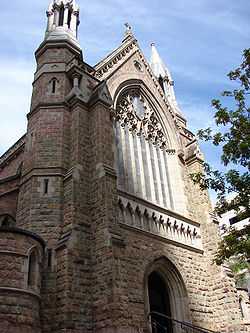Benjamin Backhouse
Benjamin Backhouse (1829-1904) was an architect and politician in Australia. He was a Member of the New South Wales Legislative Council.[1]
Early life
Benjamin Backhouse was born in England. He was a Bachelor of Arts and was educated as an architect.
Career
In early life Backhouse, with his young wife and two children, came out to Australia and settled down in Geelong, Victoria. He soon made a name for himself as an architect, and two months after his arrival succeeded in winning a hundred-guinea prize for the best design for a stock exchange for that city. Some eight years later he returned to England, and remained for a year, and then came out to Queensland. He carried on his profession for eight years, and designed some of the principal buildings in Brisbane. Although he won the design competition for the Queensland Parliament House, it was later decided that his design would be too expensive and was rejected.[2] He was also an alderman of the Brisbane Municipal Council.
For the past 35 years Backhouse resided in New South Wales. His professional skill was recognised by his election for 12 years as the chairman of the City of Sydney Improvement Board. In August, 1895, he was appointed to a seat in the New South Wales Legislative Council, which he retained until his death. Although not a union official or a Labour candidate, his sympathies were at all times with the workers. He was truly democratic, and was a follower of John Ruskin and other workers for the amelioration of society. He also identified himself with the Pitt Town Settlement, and was chairman of the board of control to look after the affairs of the settlement. Backhouse made several trips to England. On one occasion he had a long conference with William Gladstone and at another time he was honoured by being elected an honorary associate of the Royal Institute of British Architects.
Later life
Benjamin Backhouse died of heart failure at his residence, Ardath, Queen's-avenue, Rushcutters Bay, Sydney, on 29 July 1904. He was twice married, and left a widow and grown-up family, numbering 11. The sons are his Honor Judge Alfred Paxton Backhouse, and Messrs. Ernest, Clarence, Frank, Clive, Maurice, and Oscar Backhouse. In deference to his wishes, a private funeral was held.[1]
Works
- Wickham Terrace Church of England, the predecessor of All Saints Anglican Church, Brisbane (1861, no longer extant)[3]
- house Riversleigh, North Quay, Brisbane (1863, no longer extant)[4]
- Cathedral of St Stephen, Brisbane (1863)[5]
- Cintra House, Brisbane (1864)[6]
- Fernberg, Paddington, Brisbane (1864) now Government House, Brisbane[7]
- Old Bishopsbourne, Brisbane (1865)[8]
- Baroona, Paddington, Brisbane (1866)[9]
- Fortitude Valley State School, Brisbane (1867)[10]
-

Wickham Terrace Church, circa 1868
-

Front view of Riversleigh, North Quay, Brisbane, ca. 1931
-

St Stephen's cathedral, Brisbane
-

Perspective drawing of Villa Fernberg, Brisbane, ca. 1864
References
- ↑ 1.0 1.1 "DEATH OF THE HON. B. BACKHOUSE, M.L.C.". The Sydney Morning Herald (National Library of Australia). 30 July 1904. p. 10. Retrieved 4 March 2015.
 This article incorporates text from this source, which is in the public domain.
This article incorporates text from this source, which is in the public domain. - ↑ "New Parliament House". Queensland Parliament. Retrieved 4 March 2015.
- ↑ Buxton, W (1868), Original All Saints Church, Brisbane, ca. 1868, John Oxley Library, State Library of Queensland, retrieved 4 March 2015
- ↑ Unidentified (1931), Front view of Riversleigh, North Quay, Brisbane, ca. 1931, John Oxley Library, State Library of Queensland, retrieved 4 March 2015
- ↑ "St Stephens Cathedral (entry 14882)". Queensland Heritage Register. Queensland Heritage Council. Retrieved 4 March 2015.
- ↑ "Cintra House (entry 14829)". Queensland Heritage Register. Queensland Heritage Council. Retrieved 4 March 2015.
- ↑ "Government House (entry 15050)". Queensland Heritage Register. Queensland Heritage Council. Retrieved 4 March 2015.
- ↑ "Old Bishopsbourne (entry 15029)". Queensland Heritage Register. Queensland Heritage Council. Retrieved 4 March 2015.
- ↑ "Baroona (entry 15064)". Queensland Heritage Register. Queensland Heritage Council. Retrieved 4 March 2015.
- ↑ "Fortitude Valley State School (former) (entry 16872)". Queensland Heritage Register. Queensland Heritage Council. Retrieved 4 March 2015.